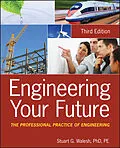Round out your technical engineering abilities with the business know-how you need to succeed
Technical competency, the "hard side" of engineering and other technical professions, is necessary but not sufficient for success in business. Young engineers must also develop nontechnical or "soft-side" competencies like communication, marketing, ethics, business accounting, and law and management in order to fully realize their potential in the workplace.
This updated edition of Engineering Your Future is the go-to resource on the nontechnical aspects of professional practice for engineering students and young technical professionals alike. The content is explicitly linked to current efforts in the reform of engineering education including ABET's Engineering Criteria 2000, ASCE's Body of Knowledge, and those being undertaken by AAEE, AIChE and ASME. The book treats essential nontechnical topics you'll encounter in your career, like self-management, interpersonal relationships, teamwork, project and total quality management, design, construction, manufacturing, engineering economics, organizational structures, business accounting, and much more. Features new to this revised edition include:
* A stronger emphasis on management and leadership
* A focus on personal growth and developing relationships
* Expanded treatment of project management
* Coverage of how to develop a quality culture and ways to encourage creative and innovative thinking
* A discussion of how the results of design, the root of engineering, come to fruition in constructing and manufacturing, the fruit of engineering
* New information on accounting principles that can be used in your career-long financial planning
* An in-depth treatment of how engineering students and young practitioners can and should anticipate, participate in, and ultimately effect change
If you're a student or young practitioner starting your engineering career, Engineering Your Future is essential reading.
Autorentext
STUART G. WALESH, PHD, PE, is an independent consultant who provides management, engineering, and education/training services to private, public, academic, and volunteer sector organizations. With over forty years of engineering, education, and management experience in the government, academic, and private sectors, Walesh has worked as a project manager, department head, discipline manager, author, marketer, sole proprietor, professor, and dean of an engineering college.
Inhalt
Preface to the Third Edition xix
Acknowledgments xxvii
List of Abbreviations xxix
Chapter 1 Introduction: Engineering and the Engineer 1
The Playing Field 1
Definitions of Engineering 3
The Seven Qualities of Effective Leaders 8
The Engineer as Builder 19
Concluding Thoughts: Common Sense, Common Practice, and Good Habits 20
Cited Sources 22
Annotated Bibliography 23
Exercises 24
Chapter 2 Leading and Managing: Getting Your Personal House in Order 27
Start with You 27
Employment or Graduate School? 46
The New Work Environment: Culture Shock? 49
The First Few Months of Practice: Make or Break Time 51
Managing Personal Professional Assets: Building Individual Equity 59
Concluding Thoughts: Getting Your Personal House in Order 67
Cited Sources 68
Annotated Bibliography 69
Exercises 70
Chapter 3 Communicating to Make Things Happen 73
Five Forms of Communication 73
Three Distinctions between Writing and Speaking 75
Listening: Using Ears and Eyes 77
Writing Tips: How to Write to Make Things Happen 80
Speaking Tips: How to Speak to Make Things Happen 97
Concluding Thoughts about Writing and Speaking 118
Cited Sources 118
Annotated Bibliography 120
Exercises 121
Chapter 4 Developing Relationships 123
Taking the Next Career Step 123
Personality Profiles 124
Maslow's Hierarchy of Needs 125
Theories X and Y 127
Delegation: Why Put Off Until Tomorrow What Someone Else Can Do Today? 129
Orchestrating Meetings 135
Working with Technologists, Technicians, and Other Team Members 145
Selecting Co-Workers and Managing Your Boss 150
Caring Isn't Coddling 151
Coaching 152
Teamwork 153
Effective Professional Meeting and Conference Attendance 158
Concluding Thoughts about Developing Relationships 163
Cited Sources 164
Annotated Bibliography 165
Exercises 166
Chapter 5 Project Management: Planning, Executing, and Closing 167
Project Broadly Defined 167
Project Management Defined 168
The Centrality of Project Management 169
Relevance of Project Management to the Student and Entry-Level Technical Person 172
Planning the Project 173
Executing the Project 188
Closing the Project 190
Closure: Common Sense and Self Discipline 192
Cited Sources 192
Annotated Bibliography 193
Exercises 194
Chapter 6 Project Management: Critical Path Method and Scope Creep 195
This Chapter Relative to the Preceding Chapter 195
The Critical Path Method 196
Scope Creep 210
Cited Sources 227
Annotated Bibliography 228
Exercises 228
Chapter 7 Quality: What Is It and How Do We Achieve It? 231
Everyone Is for It! 231
Quality Defined 232
A Caution for Engineers and Other Technical Personnel 235
Quality Control and Quality Assurance 236
Suggestions for Developing a Quality Seeking Culture 237
Tools and Techniques for Stimulating Creative and Innovative Thinking 250
Closure: Commit to Quality 264
Cited Sources 264
Annotated Bibliography 266
Exercises 267
Chapter 8 Design: To Engineer Is to Create 269
The Root of Engineering 269
This Chapter's Approach 270
Design in the Context of Major Engineering Functions 271
The Disproportionate Impact of the Design Function 274
Design in Terms of Deliverables 274
Design as Risky Business 278
Design as a Personally-Satisfying and People-Serving Process 279
